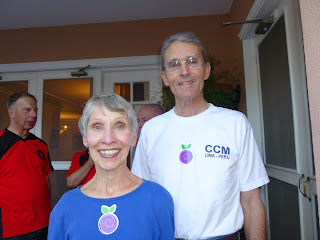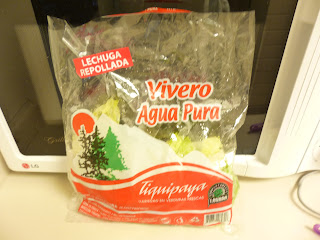One thing I've been forgetting to mention here ever since we arrived is that almost all the cars are outfitted to run on propane - isn't that interesting? The gas stations advertize "gas natural" instead of various brands of gasoline. We've been told that most if not all of the taxis, trufis and little buses run on propane or natural gas with an auxiliary gasoline engine for when they have to climb hills (because the propane/natural gas doesn't give them enough power for some of these steep hills - and maybe the altitude [i.e., lack of oxygen in the atmosphere] is a factor too. I'm not sure about that.) Anyway, that is one significant difference between here and any other place we've lived, so I thought I should remember to tell you.
Something wonderful happened at the temple this week. Three couples - members of the Uro Indian tribe who live on the floating islands of Lake Titicaca - came to the temple for their semi-annual visit. It takes them more than 24 hours to get here, mainly because of delays in buses and having to make connections, etc. They arrive fairly early on a Friday and stay in the hospedaje. One of these couples has a teenage son who helped babysit part of the time, but he also got to come to the temple and do baptisms. They attend as many sessions at the temple as they can on Friday and on Saturday morning, and then they leave after lunch on Saturday and get home about 5:00 Sunday evening. Such devotion and commitment! Here are some pictures they were happy to let us take.
This shows Farron and me and two other temple missionaries (Sister Adriana Monroy and Sister Linda Johnson) with two of the couples, just outside the temple doors.
Here we got everyone but us. The white-haired lady is another temple missionary, Sister Perez (from Venezuela) and that's Sister Monroy (from Ecuador/Colorado) in the lavender hat (not hers; it belongs to one of the Uro ladies.) The teenage boy standing in the back row belongs to the couple right beside him (she is sitting on the ground). The man holding the baby is the President of the little Branch of the Church up there. His wife is to his right and the young boy in front is theirs also. The couple on the right (she is wearing a baseball cap and standing in front of him) are the oldest of the three couples. The man might be an uncle of the other two men; we're not sure. That couple has two sons who have served as full-time missionaries and a third son who is presently serving in the Colombia Bogota North Mission.
This is just a quick picture of me with the middle couple (middle in age and middle in placement in the picture above.)
If you want to see some really beautiful pictures of these people in their own locale, Google "Uro Indians living on Lake Titicaca" and then choose "images". There are dozens of gorgeous pictures and you will see that the women are wearing these incredibly-bright garments. Also notice the bright colors on the shawl in which the baby is wrapped. That shawl is traditional weaving of their tribe (and for that matter, of all Bolivia, I think.) We see Indian women everywhere with their babies (and various other heavy loads) carried on their backs in shawls just like this one.
The native Uro language was lost some fifty years ago with the death of the last person who could speak it, but the tribe speaks Aymara (the 2nd largest Indian language in Bolivia) and Spanish. Further, they recognize that tourism has been and will continue to be literally the life-saving industry for their people, so the men (at least) are studying English (and they are making sure the children learn it too), so they can talk to tourists and be active in the tourist industry. We hope to make a trip up there before we come home, although the altitude is over 13,000 feet and that's a little scary to me after the hard time I had adjusting to the mere 9,000 feet here.
This was the highlight of our week at the temple -- meeting these people and visiting with them. Given their meager income and the difficulties of ground travel in these South American countries, I think their sacrifice to come to the temple twice a year is greater than our so-called sacrifice to come here and serve a mission. We may be giving up our time, but in every other respect we are living very comfortably (or will be if I can ever figure out how to bake at this altitude and cook with the products that are available here) - so they are sacrificing much more than we. It was a tremendous inspiration to meet them.



























































